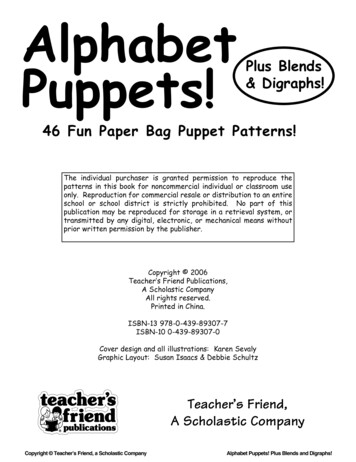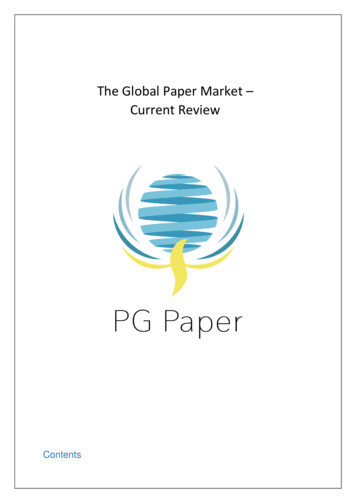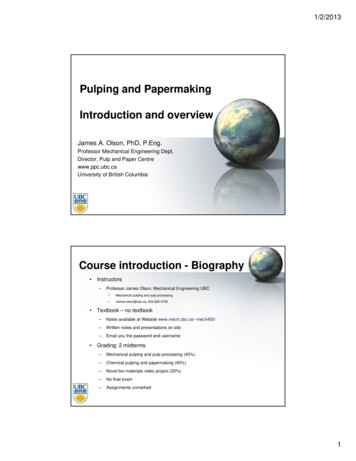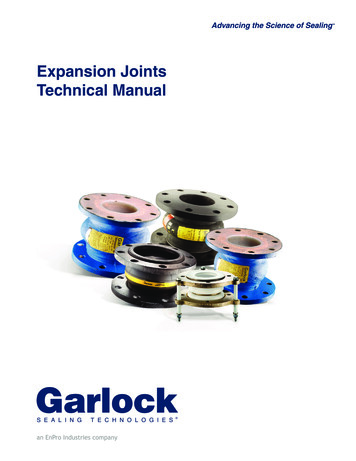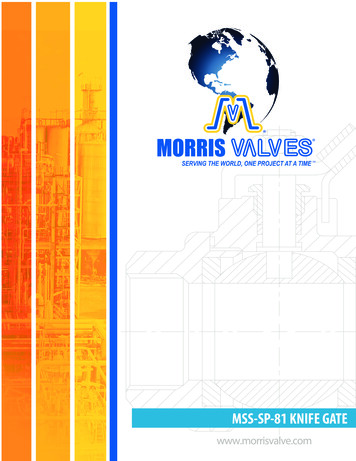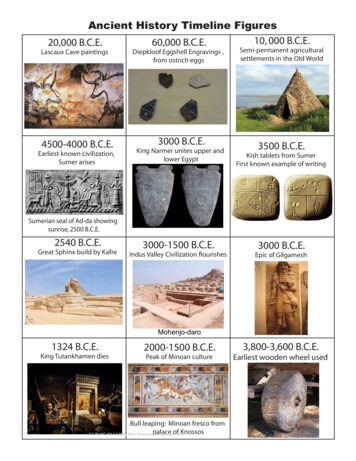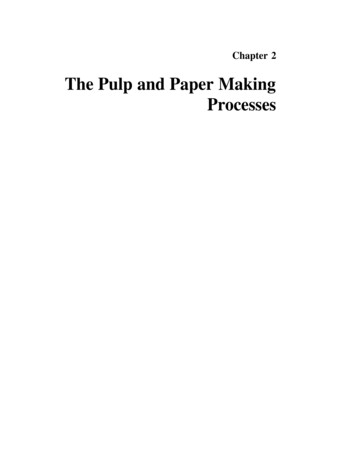
Transcription
Chapter 2The Pulp and Paper MakingProcesses
CONTENTSPageTHE PULP AND PAPER MILL. . . . . . . . . . . . . . . . . . . . . . . . . . . . . . . . . . . . . . . . . . . . . . . . . . . 17Steps in the Pulp and Papermaking Process. . . . . . . . . . . . . . . . . . . . . . . . . . . . . . . . . . . . . 18Pulping Technologies. . . . . . . . . . . . . . . . . . . . . . . . . . . . . . . . . . . . . . . . . . . . . . . . . . . . . . . . . 20PageFigure2-1.2-2.2-3.2-4.Overall View of Papermaking From Chemical Pulp by the Kraft Process. . . . . . . . . . 19Stone Groundwood Pulp Mill Flow. . . . . . . . . . . . . . . . . . . . . . . . . . . . . . . . . . . . . . . . . . . .21Refiner Groundwood Pulp Mill Process . . . . . . . . . . . . . . . . . . . . . . . . . . . . . . . . . . . . . . . . . 22Sulfite Pulp Mill Process. . . . . . . . . . . . . . . . . . . . . . . . . . . . . . . . . . . . . . . . . . . . . . . . . . . . 25TableTablePage2-1. Major Commercial Wood-Pulping Technologies . . . . . . . . . . . . . . . . . . . . . . . . . . . . . . . . . 18
Chapter 2The Pulp and Paper Making Processesimpurities that cause discoloration and possiblefuture disintegration of the paper. Hemicellulose issimilar to cellulose in composition and function. Itplays an important role in fiber-to-fiber bonding inpapermaking. Several extractives (e.g., oleoresinsand waxes) are contained in wood but do notcontribute to its strength properties; these too areremoved during the pulping process.The modem manufacture of paper evolved froman ancient art first developed in China, ca. 105 A.D.Although the modem product differs considerablyfrom its ancestral materials, papermaking retainsdistinct similarities to the processes developed byTs’ai Lun in the Imperial Chinese Court. ’ Inprinciple, paper is made by: 1) pulping, to separateand clean the fibers; 2) beating and refining thefibers; 3) diluting. to form a thin fiber slurry,suspended in solution; 4) forming a web of fibers ona thin screen; 5) pressing the web to increase thedensity of the material; 6) drying to remove theremaining moisture; and 7) finishing, to provide asuitable surface for the intended end use.The fiber from nearly any plant or tree can be usedfor paper. However, the strength and quality of fiber,and other factors that can complicate the pulpingprocess, varies among tree species. In general, thesoftwoods (e.g., pines, firs, and spruces) yield longand strong fibers that impart strength to paper andare used for boxes and packaging. Hardwoods, onthe other hand, generally have shorter fibers andtherefore produce a weaker paper, but one that issmoother, more opaque, and better suited for printing. Both softwoods and hardwoods are used forpapermaking and are sometimes mixed to provideboth strength and printability to the finished product.Pulp and paper are made from cellulosic fibers(i.e., fibers from trees) and other plant materials,although some synthetic materials may be used toimpart special qualities to the finished product. Mostpaper is made from wood fibers, but rags, flax,cotton linters, and bagasse (sugar cane residues) arealso used in some papers. Used paper is alsorecycled, and after purifying and sometimes deinking, it is often blended with virgin fibers andreformed again into paper. Other products madefrom wood pulp (cellulose) include diapers, rayon,cellulose acetate, and cellulose esters, which areused for cloth, packaging films, and explosives.THE PULP AND PAPER MILLAlthough there are several chemical and mechanical pulping methods used for delignifying wood(table 2-l), separating fibers, and removing discoloration, all integrated pulp and paper mills involvethe same general steps in the manufacture of pulpand paper. These steps include: 1 ) raw materialpreparation (e.g., debarking and chipping); 2) mechanical and/or chemical separation of the woodfibers [i.e., grinding, refining, or digestion (cooking)] to dissolve the lignin and extractives; 3)removal of coloring agents (primarily residual lignin) by bleaching; and 4) paper formation andmanufacture.Wood is composed of: 1) cellulose, 2) lignin, 3)hemicellulose, and 4) extractives (e.g., resins, fats,pectins, etc.). Cellulose, the fibers of primaryinterest in papermaking, comprises about 50 percentof wood by ovendry weight. Lignin, which cementsthe wood fibers together, is a complex organicchemical the structure and properties of which arenot fully understood, It is largely burned for thegeneration of energy used in pulp and paper mills.As the chemistry of lignin becomes better understood, what is now mostly a waste product used forfuel (some is converted to chemical products) couldbecome a valuable feed stock for new chemicalproducts.A typical layout of a mill using the kraft chemicalpulping process is shown in figure 2-1. Mechanical,semichemical, and sulfite pulp mills differ in detail,particularly in wood preparation, fiber separation,and bleaching, but many of the downstream refining,bleaching, and papermaking processes are similar.In addition to the primary steps in pulp and papermanufacture, each mill has extensive facilities toThe pulping process is aimed at removing asmuch lignin as possible without sacrificing fiberstrength, thereby freeing the fibers and removingIA, H,Nlss , p p , WOO Ifs (ruC e U p?ope?(ies, F.F, Wangaard (cd.) (University Park, PA: Pennsyivtia State University 198 1)! P 3 5.-17-
18 Technologies for Reducing Dioxin in the Manufacture of Bleached Wood PulpTable 2-l—Major Commercial Wood-Pulping TechnologiesPulp grades useWood typeEnd-product useChemical pulps:sulfite pulp . . . . . . . . . . . . . . . . . . . . . . . . . . . Softwoodsand hardwoodsKraft sulfate pulp . . . . . . . . . . . . . . . . . . . . . .Softwoods and hardwoodsDissolving pulp . . . . . . . . . . . . . . . . . . . . . . . . Softwood S and hardwoodsFine and printing papersBleached-printing and writing papers, paperboardUnbleached-heavy packaging papers, paperboard.Viscose rayon, cellophane, acetate fibers, and filmSemichemical pulps:Cold-caustic process . . . . . . . . . . . . . . . . . . . Softwoods and hardwoodsNeutral sulfite process . . . . . . . . . . . . . . . . . . HardwoodsNewsprint and groundwood printing papersNewsprint and groundwood printing papersMechanical pulpsStone groundwood , . . . . . . . . . . . . . . . . . . . SoftwoodsRefiner mechanical (RMP) . . . ., . . . . . . . . . SoftwoodsThermomechanical (TMP) . . . . . . . . . . . . . . .SoftwooodsSOURCE: Modifhd from George H. Soyd Ill and Chad E. Srown, Paper / sfFy:Corrugating mediumNewsprint and groundwood printing papersNewsprint and groundwood printing papers tbok b Market Pu/p (New York, NY: KiddM, Peabody & (h, 19S1 ), p. 5.produce and reclaim chemical agents used in thepulping process; collect, process, and bum ligninand waste wood to produce energy; and remove andtreat wastes from process water for release into theenvironment.Steps in the Pulp and Papermaking ProcessRaw Material PreparationWood received at a pulp mill may be in severaldifferent forms, depending on the pulping processand the origin of the raw material. It maybe receivedas bolts (short logs) of roundwood with the bark stillattached, as chips about the size of a half-dollar thatmay have been produced from sawmill or veneermill waste or pre-chipped from debarked roundwoodelsewhere, or as waste sawdust in the case of somepulping processes.If roundwood is used, it is first debarked, usuallyby tumbling in large steel drums where wash watermay be applied. The debarked wood bolts are thenchipped in a chipper if the pulping process calls forchemical digestion or are fed into a grinder in thecase of some mechanical pulps. Chips are screenedfor size, cleaned, and temporarily stored for furtherprocessing.Fiber SeparationThe fiber separation stage is the point at which theseveral pulping technologies diverge. In kraft chemical pulping, the chips are fed into a large pressurecooker (digester), into which is added the appropriate chemicals (white liquor). The chips are thencooked (digested) with steam at specific temperatures long enough to separate the fibers and partiallydissolve the lignin and other extractives.Some digesters operate continuously with a constant feed of chips (furnish) and liquor, others arecharged intermittently and treat a batch at a time.After digestion, the cooked pulp (brown stock) isdischarged into a pressure vessel (blow tank) wherethe steam and volatile materials are siphoned off.The cooking liquor, that by this time has turned darkbrown from the dissolved lignin (black liquor), isreturned to the chemical recovery cycle, In thechemical recovery plant, the lignin in the blackliquor is burned for the cogeneration of energy, andthe chemicals are recovered, purified, reconstituted,and returned to the digester as white liquor for reuse.The brown stock containing the recovered fibers(having the consistency of cooked oatmeal) iswashed with water, screened to remove undigestedwood, and cleaned to remove other foreign matter.It is then ready for bleaching and further processing.Fiber separation in mechanical pulping is lessdramatic. In the stone groundwood process, debarked logs are forced against rotating stone grinding wheels that are constantly washed by a stream ofwater. The ground pulp is then screened to removecourse debris, thickened, and stored for the papermaking process.Chips are used to produce refiner pulp andthermomechanical pulp. In both processes the chipsare ground by passing them through rapidly rotating
Chapter 2—The Pulp and Paper Making Processes 19Figure 2-1-Overall View of Papermaking From Chemical Pulp by the Kraft ProcessContinuous digesterIIWhite liquorclarifierWash waterIIStripped condensatesSOURCE: Envirorwnent Ontario, Srop@ng Water Poflutioft Al Its Source (Toronto, OntarIO: Ministry of the Environment, 1988).A
20 Technologiesfor Reducing Dioxin in the Manufacture of Bleached Wood Pulpdisk grinders. Thermomechanical pulp is refined(ground) under pressure after the chips are pretreatedwith steam (chemical thermomechanical pulp useschemicals and steam for pretreatment). After furtherrefining in a second stage, the pulp is screened,cleaned, and most of the process water is removed inpreparation for papermaking.Bleaching or BrighteningSince the raw pulp (brown stock) still contains anappreciable amount of lignin and other discoloration, it must be bleached to produce light colored orwhite papers preferred for many products. Bleachingis normally done in several stages (multistagebleaching). Through chlorination and oxidation thefibers are further “delignified” by solubilizingadditional lignin from the cellulose.A number of bleaching agents may be used andare applied in a stepwise fashion within a bleachingsequence. These include chlorine gas, chlorinedioxide, sodium hypochlorite, hydrogen peroxide,and oxygen. Between bleaching treatments, a strongalkali (usually sodium hydroxide) is used to extractthe dissolved lignin from the surface of the fibers.The bleaching agents and the sequence in which theyare used depend on a number of factors, such as therelative cost of the bleaching chemicals, type andcondition of the pulp, desired brightness of the paperto be produced, and sometimes in response toenvironmental guidelines and regulations.Bleaching of mechanical pulp is much differentthan that for chemical pulp. Mechanical pulpingleaves the lignin and the cellulose intact, whereas thepurpose of chemical pulping is to chemically separate the lignin from the cellulose fibers and removeit from the pulp. A major advantage of mechanicalpulping is the high yields of pulp that can beachieved from a given volume of wood. Therefore,bleaching or brightening of mechanical pulps isdesigned to minimize the removal of the lignin thatwould reduce fiber yields.Chemicals used for bleaching mechanical pulpsselectively destroy coloring impurities but leave thelignin and cellulosic materials intact, These includesodium bisulfite, sodium or zinc hydrosulfite (nolonger used in the United States), calcium or sodiumhypochlorite, hydrogen or sodium peroxide, and theSulfur Dioxide-Borol Process (a variation of thesodium hydrosulfite method). Originally, much ofthe mechanical pulp was not bleached, but thebleaching of groundwood has increased and improved technology now enables bleached groundwood pulp to be used for printing papers, tissues, andtowelling.PapermakingThe bleached or unbleached pulp may be furtherbeaten and refined to cut the fibers and roughen thesurface of the fibers (fibrillate) to improve formationand bonding of the fibers as they enter the papermachine. Before entering the paper machine, wateris added to the pulp slurry to make a thin mixturenormally containing less than 1 percent fiber. Thedilute slurry is then cleaned in cyclone cleaners andscreened in centrifugal screens before being fed intothe ‘‘wet end* of the paper-forming machine.In the paper making process, the dilute stockpasses through a headbox that distributes the fiberslurry uniformly over the width of the paper sheet tobe formed. The “web” of fiber that will make thenew paper sheet is formed on a continuously movingbronze or polymer screen (Fourdrinier) or betweentwo such wire screens. Water drains from the slurrythrough the mesh of the screen, the wet paper web isconsolidated and the paper sheet gains some strengththrough fiber bonding.The wet sheet of paper is continuously lifted fromthe screen (couched) and transferred to a woven feltbelt where additional water is squeezed from thepaper sheet by pressure rollers, The remaining wateris removed on steam-heated cylinders. When thepaper is dry it may be treated with stabilizingmaterials and surface finishes to improve durabilityor printability.Pulping TechnologiesMechanical Pulping ProcessesThere are six basic mechanical pulping processes:1 ) stone groundwood, 2) refiner, 3) thermomechanical pulping, 4) chemical mechanical, 5) defibratedor2exploded pulping, and 6) recycled paper. Mechanical pulping is generally used with softwoods be-2 1s Uon lplng IWhno]ogies IYCXTOWS heavily from a previous OTA assessment: Wood Use U.S. Co etitiveness and Technolo , Vol. //:Technical Report, OTA-M-224 (Springfkld, VA: National Technical Intormaiion Wvice, 1984), pp. 79-94.
Chapter 2—The Pulp and Paper Making ProcessesIn the stone groundwood process, debarked shortlogs (roundwood) are fed whole against wet stonegrinders by hydraulic rams. Counter-revolving steeldisks are sometimes used in place of abrasive stonein the grinding process. The abrasion of the grindingwheel against the wood physically separates thewood fibers. The grinding process usually is automatic and continuous. The groundwood pulp is thenscreened, bleached or brightened, treated, and prepared for the paper machine (figure 2-2).Mechanical pulps are used principally to manufacture newsprint, printing papers, towelling, tissue,Figure 2-2-Stone Groundwood Pulp Mill FlowOver f lowW h itewater1IBleachingPulp21and coated specialty papers that do not requirehigh-strength. Secondary uses include wallpaperand paperboard. Small amounts of chemical pulp areoften mixed with groundwood pulp for additionalstrength. Recycled pulp is used mainly for themanufacture of folding boxboard (gray board), tissue, corrugated board, and newsprint. Paper products made from defibrated pulp include hardboards,construction boards, and roofing papers.cause of the added strength imparted by the longfiber length of softwood species. Some hardwoodsrequire chemical pretreatment (chemical mechancialpulping) to produce a suitable groundwood pulp.Fibers separated mechanically are substantially damaged in the process and therefore make weaker paperor paperboard. However, since both lignin andcellulose fibers remain intact, the yield of paper perunit volume of wood is still greater than thatproduced by chemical pulping. Pulp yields from allof the mechanical pulping processes typically arenear 90 to 95 percent recovery, which is a muchhigher yield per unit of wood than with the chemicalpulping methods because of the retention of lignin.However, paper made from mechanical pulp discolors and becomes brittle with age because of its lignincontent, which results in a shorter useful life thanpaper made from chemical pulp., ISOURCE: Man M. Spdnger, Inolmrk?i Emwo rvmwtal Centi: RJ/p @ Psper hdmtry (New Yoik, NY: Jotm Wiley & Sons, 19SS), p. 147.S ewe r
22 . Technologies for Reducing Dioxin in the Manufacture of Bleached Wood PulpRefiner mechanical pulping (RMP) uses chipsin lieu of roundwood and produces paper with higherstrength than conventional groundwood because ofless damage to the fibers in the pulping process. Thechips are passed through a refiner that has fixed androtating disks operating under a stream of water. Awider range of species, including hardwoods, can beprocessed by the refiner pulping process, Sawdustand other saw mill wastes can also be used (figure2-3).Figure 2-3-Refiner Groundwood Pulp Mill Process1Thermomechanical process (TMP) was developed as a modification of the refiner mechanicalpulping process. In TMP, the wood chips aresteamed for several minutes under pressure andsubsequently refined in one or two stages. The ligninis softened by heating the wood chips with pressurized steam before they are refined (i.e., blended bypassing the fiber through rapidly rotating disks). Therefined wood pulp, although stiIl weaker thanchemical pulp, makes a stronger paper than groundwood or refiner pulp with only a small sacrifice inyield but with large energy requirements. Somenewsprint is now produced wholly from thermomechanical pulp, thus eliminating the need forthe addition of chemical pulp often needed forstrengthening paper made from mechanical pulp.The neutral sulfite semichemical (NSSC) pulpingprocess is used at a number of U.S. mills to producecourser-grade products such as corrugated board,which has a yield of about 75 percent of the woodraw material. In NSSC pulping, wood chips aresoftened by briefly cooking them in a neutral sodiumor ammonium sulfite solution and then separatingthe fibers (defibrating) in a refiner (see also SulfitePulping below).Recycling can effectively reduce the consumptionof both wood raw material and energy when used inconjunction with other mechanical pulping processes. It does so, however, with some sacrifice inpaper strength. Recycled pulp is manufactured fromwastepaper that is processed into paper stock. Asmall proportion of the paper stock (5 to 10 percent)is de-inked, usually with caustic soda-based chemicals. Most recycled paper, however, is pulpedwithout de-inking. Pulping is accomplished throughviolent agitation and shearing action performed athigh temperatures. The paper produced from recycled pulp is generally weaker than papers fromSOURCE: AJIuI M. Sprhqor, l&S EAWWWW c%@Vl: Al@wdP@NJnlAls&y(Nr# York, NY: John Wiley& Sarrs, 1986), p. 140.virgin materials, because of the breakdown of theused fibers and loss of fiber bonding.
Chapter 2—The Pulp and Paper Making ProcessesThree major developments in mechanical pulpingtechnologies show promise for improving pulpquality: 1) pressurized groundwood pulping, 2)chemical thermomechanical pulping, and 3) hardwood chemical mechanical pulping. All of thesetechnologies have reached some stage of commercialization. Chemical thermomechanical pulping iscurrently used at several U.S. mills. Improvementsin mechanical pulping show promise for improvingthe quality (strength characteristics) of paper nowproduced by mechanical processes. The resultinghigher quality mechanical pulps may displace thekraft pulps that are currently mixed with mechanicalpulps to improve paper strength.Pressurized Groundwood Pulping—h pressurized groundwood pulping, debarked logs are fed tothe grinding wheel through a heated, pressurizedchamber. The heat and pressure help separate thefiber, thus breaking fewer fibers in the grindingprocess and improving pulp quality. Paper producedfrom pressurized groundwood pulp is more tearresistant than paper made from stone-ground pulp,but is slightly inferior to that of thermomechanicalpulp. Pressurized groundwood pulping may have thepotential for displacing some high-quality chemicalpulps in the manufacture of newsprint and otherprinting papers.Chemical Thermomechanical Pulping— Chemical thermomechanical pulping involves treatingsoftwood chips with mild sulfite solutions to modifythe lignin and partially delignify the wood prior togrinding in a refiner. This “sulfonation” treatmentresults in paper with higher tear resistance thanthermomechanical, refiner, or stone-ground pulps.Pulp yields decrease slightly to between 85 and 90percent with chemical thermomechanical pulping,but these yields are still higher than chemicalpulping (40 to 56 percent).Hardwood Chemical Mechanical Pulping— Mechanical methods for producing pulp from hardwoodspecies involve pretreating hardwood chips withhydrogen peroxide or sodium hydroxide and processing them like refiner mechanical pulps. Bothhardwoods and softwoods have been successfullypulped by this method, with fiber recoveries in the80 to 90 percent range. Pulp produced by hardwood 23chemical mechanical pulping can be used to producenewsprint and printing papers.Chemical PulpingChemical pulping involves treating wood chipswith chemicals to remove the lignin and hemicellulose, thus separating and cleaning the fibers. Delignification gives the fibers greater flexibility, resulting in a substantially stronger paper (because ofgreater contact between the fibers in the finishedsheet) than can be manufactured from high-ligninfibers produced by mechanical pulping. Paperstrength and durability is gained at the expense offiber yield. Chemical processes may yield only halfthe fiber that can be recovered by the use ofmechanical pulping techniques.Two major chemical pulping processes are currently in commercial use: 1) kraft (sulfate) pulping,and 2) sulfite pulping. The kraft process dominatesthe pulp and paper industry, accounting for 76percent of the pulpproduced for paper and paper3board in 1984. Paper produced from kraft pulpaccounts for most of the bleached boxboard andlinerboard used by the packaging industry (whichconsumes about 58 percent of the paper in the UnitedStates). Bleached softwood kraft pulps are oftenmixed with mechanical pulps to add strength tonewsprint and printing papers. Bleached hardwoodkraft pulps are added to bleached softwood pulp toimprove printability for specialty paper productslike magazine stock and coated papers. Both kraftpulp and sulfite pulp can be used for the productionof dissolving pulp, which is used for the productionof rayon and acetates.Kraft Pulping—Kraft pulping involves treatingwood chips and sawdust with a sodium sulfide andsodium hydroxide solution (see figure 2-1). Thehighly alkaline chemical and wood mixture iscooked with steam under pressure (digested) forbetween 1 and 3 hours. Digestion may be either acontinuous process or treated in discontinuous‘‘batches.’ Most of the lignin and some of thehemicellulose is dissolved, leaving the remainingcellulose fibers separated.The cooking liquor containing the dissolvedlignin and other extractives (black liquor) is routedto a chemical recovery plant where the lignin and
24 Technologies for Reducing Dioxin in the Manufacture of Bleached Wood Pulporganic wastes are burned to produce energy neededin the pulping process. Valuable extractives (e.g.,turpentine, tall oil, and resin) are separated for saleas commodity chemicals. Process chemicals arerecovered with only a relatively small loss involume, and after replenishment with sodium salts,they are returned to the digester for reuse.The brown pulp (brown stock) from the digesteris washed, screened, and passed through a battery ofcleaners. If the pulp is to be bleached, it is“thickened” by removing excess water and sentthrough a series of bleach operations. These can varywidely in the type of chemicals used and theirsequence. Bleached pulp is then ready for the papermaking process.Both softwood and hardwoods can be pulped bythe kraft process. Fiber recovery is largely a functionof the wood species used, the time and temperatureof cooking, the degree of bleaching, and the paperstrength required. Generally, kraft pulp recoveriesfrom softwoods are approximately 47 percent for4unbleached pulp and 44 percent for bleached.Hardwood recoveries range from 50 to 52 percent forunbleached kraft pulp to 50 percent for bleached.Sulfitee Pulping—Lignin can be dissolved bysulfonation with an aqueous solution of sulfurdioxide and calcium, sodium, magnesium, or ammonium bisulfite cooked at high temperature andpressure in a digester (see figure 2-4). There are fourbasic sulfite pulping processes currently in commercial use: 1) acid sulfite, 2) bisulfite, 3) neutral sulfite,and 4) alkaline sulfite. The major differences between the sulfite processes are the levels of acidityand alkalinity of the sulfite chemical solutions usedto break down the wood and remove the lignin.Sulfite pulping processes are suitable only forspecies with low extractive contents (i.e., those lowin tannins, polyphenols, pigments, resins, fats, andthe like) because of the interference of thesesubstances with the sulfite pulping process. Although calcium is the cheapest sulfite base available,it forms insoluble compounds that cannot be reclaimed economically. Thus, calcium-based pulpingis seldom used. Because magnesium- and sodium-based chemicals are recoverable, and ammoniumbased chemicals are less expensive and can beburned without harmful environmental effects, theyare the most frequently used.Sodium-based sulfite pulping can consist ofmultistage cooking, successive stages of whichdiffer in acidity. Because one stage optimizeschemical liquor penetration and the other the removal of lignin, more lignin may be removed withless fiber degradation, so that fiber yields are higher,fibers are stronger, and a wider range of woodspecies may be used. Sulfite pulping dissolves someof the hemicellulose as well as the lignin. Neutralsulfite pulping, using sodium and ammonium bases,recovers the largest proportion of fiber (75 to 90percent) of all the sulfite pulping methods.Sulfite pulp is a light color and can sometimes beused without bleaching if high brightness is notrequired. Unbleached sulfite pulp is often blendedwith groundwood and other high-yield mechanicalpulps for strengthening newspaper stock. Sulfitepulp is easily bleached to very bright pulps forwriting and printing paper. It is also used for themanufacture of dissolving pulps (through the furtherremoval of hemicellulose) for the production ofviscose rayon, acetate fibers and films, plastic fillers,and cellophane.Potential for New Pulping TechnologiesThe search for new pulping technologies andprocess improvements for established commercialtechnologies continues in the United States, Canada,Sweden, Finland, Japan, Germany, and elsewhere.In the United States, about 815 million is estimatedto have been spent on pulpand paper research and5development in 1987. OTA could not determinewhat proportion of the R&D was directed atimproving pulping technologies. Nearly all R&D issponsored by the industry, with only 3 million( 0.4 percent) expended by the Federal Government.Industry pulping R&D is largely focused onimproving established pulping and bleaching processes rather than seeking new pulping technologies.Some of the research and development is driven by4P.J. I-Iw y, Cowri on of Mills Ener Balance: Efects of Conventional Hydropyrolysis and ry Pyrolysis Recoveq system (Awlem WI:Institute of Paper Chemistry, 1978),5Bat ]]e Memolj stitute, pro le Leveb of R&D Expenditures in 1987: Forecau and Analysis (Columbus, OH: Battelle, 1986), P. 11.
Chapter 2—The Pulp and Paper Making Processesthe need for broadening the raw material base inresponse to concerns over forest resources. Restrictions on water use and pollution control havecontributed to the impetus for seeking processimprovements. 25Figure 2-4—Sulflte Pulp Mill ProcessFresh waterWood —-J----:Energy costs as reflected in both energy use by theindustry and their impact on the cost of chemicalshas led to process improvements in the past,although moderating energy prices have recentlyreduced these concerns. The emphasis on recyclingto reduce the massive problems of solid wastedisposal in metropolitan areas has also been anincentive to using more reclaimed material in papermanufacturing. Finally, the increasing cost of capitalto rebuild aging sectors of the pulp and paperindustry have fed the need for more R&D by theindustry.There are several reasons why major advancements in pulp and paper technology appear to beglacial in comparison to some other more rapidlyadvancing technologies. First, the pulp and paperindustry is mature; the commercial technology,much of which was developed in the late 1700s and1800s, has undergone evolutionary change, andsatisfaction with the basic technology has led to littlereason to fix something that does not appear to bebroken. Concerns over future environmental problems and competition from other materials couldchange this, and to some degree already has.Second, R&D is fragmented by the emphasis onprocess improvement, therefore few scientists andengineers focus on new pulping processes. Inaddition, many researchers specialize in one pulpingprocess or another depending on the needs of aspecific firm; few are able to consider all technological options or innovations for improving pulp yieldor overall quality.Third, R&D investment in incremental improvement in established processes is easier to sell tocorporate directors than risky, long-term, radicalchanges. Large existing investments in plant equipment stretch the amortization period of old equipment and slow the acceptance of new processes thatrequire substantial changes and alterations.Finally, the absen
The Pulp and Paper Making Processes The modem manufacture of paper evolved from an ancient art first developed in China, ca. 105 A.D. Although the modem product differs considerably from its ancestral materials, papermaking retains distinct similarities to the processes d



